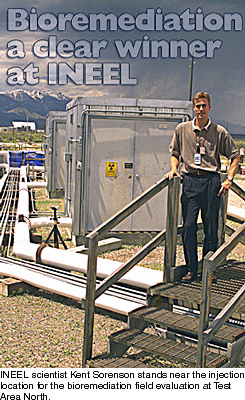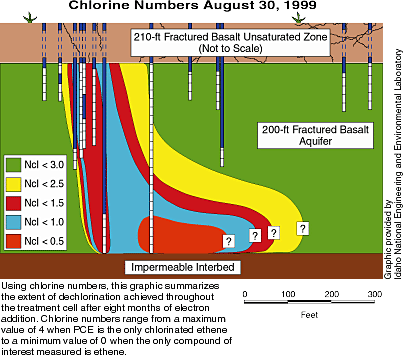
In situ bioremediation has beaten out four other technologies at the Idaho National Engineering and Environmental Laboratory (INEEL) in a bid to replace pump and treat as the technology of choice for remediating a trichloroethylene (TCE)-contaminated groundwater plume at the site’s Test Area North (TAN). In a year-long test that has been touted as the largest in situ bioremediation (ISB) project of its kind in the United States and the first in the world to attempt bioremediation of groundwater in a deep fractured-rock aquifer, ISB has demonstrated its efficacy and efficiency in stimulating indigenous bacteria to metabolize TCE into harmless constituents. Kent Sorenson, principal scientist and engineer in the Geomicrobiology Group at INEEL, is enthusiastic about the project’s significance in unlocking some of the mysteries involved in engineered bioremediation. “One of the really exciting things about this project is that 20 years ago TCE was thought to be nonbiodegradable, but now we’ve shown that simply by enhancing natural processes, we can destroy TCE even in a deep fractured-rock setting.” The technology’s spectacular performance has set the regulatory wheels in motion, through a Record of Decision (ROD) amendment, to deploy ISB at the site. The demonstration project, which began in November 1998 as a Superfund activity under the office formerly known as Environmental Restoration (EM-40), is continuing, and its benefits are being extended with additional funding being provided by the Office of Science and Technology (EM-50) through an Accelerated Site Technology Deployment project (see sidebar). The little critters must
“eat” Periodic monitoring showed the researchers that reductive dechlorination of TCE was occurring. The bacteria metabolized the sodium lactate and converted it into propionate and acetate—compounds that were further degraded as they donated electrons that provided energy to the bacteria for the next steps: reduction of TCE first to one or more phases of dichloroethene (DCE), further reduction to vinyl chloride, followed by production of the harmless by-product ethene. Finding evidence of enhanced
bioremediation
The reduction in source contamination was inferred from an increase in DCE products that more than offset TCE reduction, suggesting not only that aqueous TCE was being transformed to its DCE breakdown product, but that sorbed TCE from the source was also being degraded. The capability to reduce the TCE source distinguishes ISB from a pump-and-treat system, which is incapable of treating the source of the problem and would have to be operated indefinitely to clean up groundwater as it continues to be contaminated by residual DNAPL. Researchers estimate that a pump-and-treat system would cost roughly twice as much as an ISB system due to the shorter lifetime operation required for an ISB system. During the last two months of the test, researchers made a discovery that has significant implications for the success of a long-term ISB project. The scientists stopped pumping sodium lactate underground and discovered that the reductive dechlorination process not only continued but sped up. Instead of relying on the sodium lactate, the microbes became more efficient at using intermediate breakdown products, resulting in more complete dechlorination over a larger area. The increased rate of reductive dechlorination may be related to the concentration of hydrogen in groundwater induced by the different electron donors. At the high hydrogen concentrations typical of lactate degradation, microbial activity is indiscriminately encouraged. At the lower hydrogen concentrations expected during propionate degradation, however, laboratory studies have suggested that dechlorinators outcompete other organisms, such as methanogens, for the electron donor. This pattern of dechlorination suggests a long-term strategy for lactate addition that might optimize dechlorination—large but infrequent pulses of lactate. Such a strategy would take advantage of lactate’s ability to stimulate the appropriate geochemical conditions rapidly, while also benefiting from prolonged periods of increased dechlorination efficiency associated with propionate.
Other competitors
Traditional pump-and-treat technologies are incapable of treating dense, nonaqueous-phase liquids like TCE in a cost-effective manner and within a reasonable time frame. ISB’s performance at TAN is yielding the kind of cost and performance data that are building the track record for ISB and offering hope that contaminated groundwater can be reclaimed in the foreseeable future. For more information on INEEL’s TAN groundwater bioremediation project, contact
Kent Sorenson, project engineer, at (208) 526-9597, sorenks@inel.gov. |

 Another significant finding to support the use of ISB at TAN was
evidence that the technology is able to attack TCE contamination at its source, not merely
the contamination that is dissolved in groundwater. Principal engineer Sorenson says,
“The degree of impact bioremediation is having on the residual source was a pleasant
surprise with important implications. If we can demonstrate similar effects at other
sites, it will really open the door to a wide range of applications for the
technology.”
Another significant finding to support the use of ISB at TAN was
evidence that the technology is able to attack TCE contamination at its source, not merely
the contamination that is dissolved in groundwater. Principal engineer Sorenson says,
“The degree of impact bioremediation is having on the residual source was a pleasant
surprise with important implications. If we can demonstrate similar effects at other
sites, it will really open the door to a wide range of applications for the
technology.”